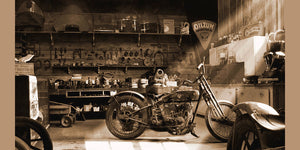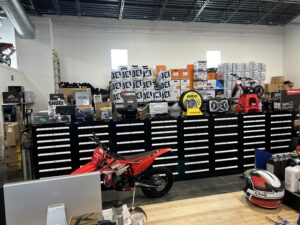Let Loose Efficiency with Premium Motox Parts NZ Available Below
Let Loose Efficiency with Premium Motox Parts NZ Available Below
Blog Article
Recognizing the Vital Parts of a Motorcycle: A Comprehensive Overview for Fanatics
For bike enthusiasts wanting to elevate their riding experience and ensure their bikes run efficiently, recognizing the crucial elements of a motorcycle is critical. Each element, from the engine's complex operations to the critical function of the braking mechanisms, not only impacts efficiency however additionally safety and security and convenience. This guide will certainly walk via the fundamental components that every motorcyclist need to recognize with, making it possible for educated options in both maintenance and possible upgrades. As we start this expedition, one must ask: just how does each part connect to develop the smooth adventure every fanatic seeks?
Engine Components

The camshaft plays an essential duty in regulating the timing of the engine's shutoffs, ensuring the accurate opening and closing necessary for reliable gas and air consumption, as well as exhaust expulsion. This timing is vital to maintaining ideal engine efficiency and performance. Additionally, the carburetor or gas injection system, depending upon the motorbike model, is accountable for blending air with gas in the appropriate proportion for burning.
The air conditioning system, either air or liquid-based, functions to keep the engine's temperature within functional limitations, avoiding getting too hot and guaranteeing longevity - motocross gear. Each element, diligently made and integrated, adds to the seamless operation of the engine, specifying the motorbike's power outcome and general efficiency
Transmission System
Essential to the motorbike's performance, the transmission system guarantees reliable power transfer from the engine to the wheels. This system comprises numerous crucial components, consisting of the clutch, transmission, and final drive, each playing a vital role in equating the engine's power into motion. The clutch, generally run by a hand lever, offers to involve and disengage the engine from the transmission, enabling for smooth equipment adjustments and regulated velocity.
The transmission, frequently described as the transmission correct, includes a set of gears that cyclists can by hand change via to readjust the bike's speed and torque output. These equipments are arranged in a sequence that enables the motorbike to increase smoothly and maintain optimum engine efficiency across various speeds. Most bikes use a sequential transmission, calling for the motorcyclist to move equipments in a predetermined order.
Braking Devices
While understanding the transmission system is vital to using a motorbike's power, equally crucial is the capability to control and quit that power properly, which is where stopping mechanisms enter play. Brakes are vital for safety and security and efficiency, giving the rider with the essential control to navigate various terrains and conditions. Generally, motorcycles feature 2 sorts of braking systems: disc brakes and drum you can look here brakes.
Disc brakes are much more common in modern-day bikes due to their remarkable performance. This system provides better warm dissipation, consistent efficiency, and riding gear improved stopping power, especially in wet conditions.
On the other hand, drum brakes, though less common, are still discovered in some motorcycles. They function by pressing brake shoes against the internal surface of a drum connected to the wheel. While generally less reliable in warm dissipation and quiting power, drum brakes are less complex and much more affordable.
Understanding these braking systems' nuances enables riders to maintain their bikes properly and value the engineering that makes certain efficient and secure quiting.
Suspension and Steering
Suspension and guiding systems are vital parts that dramatically influence a bike's handling and experience convenience. The suspension system, consisting of forks at the front and shock absorbers at the back, takes in roadway abnormalities, enhancing stability and control. Front forks, commonly telescopic or upside down, compress and rebound to mitigate impacts, while back shock absorbers preserve tire contact with the road, essential for traction and security.
Guiding, centered around the handlebars, connects the motorcyclist to the motorbike's directional control. The steering head bearings guarantee smooth procedure, enabling precise ability to move. Proper alignment and maintenance of these bearings are essential for predictable guiding feedback and minimizing rider tiredness.
The suspension's adjustability is another critical aspect; preload, damping, and rebound setups allow personalization to suit different riding conditions and designs. This versatility is necessary for enhancing efficiency, whether browsing urban streets or taking on rugged tracks. Technologies like digital shock absorber provide real-time changes, boosting ride top quality across varied terrains.

Electrical Solutions
After ensuring a regulated and smooth adventure via efficient suspension and guiding systems, attention transforms to the electric systems, a pivotal aspect of modern-day motorbikes. These systems play a critical role not just in beginning the engine however also in powering different components that boost the capability and safety of the motorcycle.
At the heart of a motorcycle's electric system is the battery, which stores electric energy required for starting the engine and powering complementary systems - motocross gear nz. The alternator or generator, paired with the rectifier-regulator, makes certain the battery stays billed while the motorbike functions, transforming mechanical power into electrical energy and maintaining voltage degrees
The ignition system, an additional crucial element, is accountable for firing up the air-fuel blend in the engine's cyndrical tubes. Modern motorcycles frequently utilize an electronic ignition system, supplying street bikes for sale greater efficiency and dependability compared to standard systems.
Illumination systems, consisting of fronts lights, tail lights, and indications, are additionally vital, making sure presence and safety for the motorcyclist. Additional digital elements such as sensors, control devices, and presents add to innovative features like gas shot management, anti-lock braking systems (ABDOMINAL), and electronic dashboards, further enhancing the riding experience.
Verdict
A detailed understanding of a motorcycle's vital parts, consisting of the engine, transmission system, stopping systems, suspension, steering, and electrical systems, is crucial for fanatics aiming to optimize convenience, performance, and safety and security. Mastery of these elements enables notified decisions concerning upkeep and upgrades, ultimately enhancing the riding experience. By incorporating this knowledge, riders can ensure their bikes operate at peak efficiency and integrity, thus maximizing both satisfaction and durability of their vehicles.
For motorcycle enthusiasts looking to raise their riding experience and guarantee their bikes run smoothly, comprehending the important components of a bike is critical.Essential to the motorcycle's capability, the transmission system makes certain efficient power transfer from the engine to the wheels.While comprehending the transmission system is vital to taking advantage of a motorbike's power, just as important is the capacity to manage and stop that power effectively, which is where braking mechanisms come into play. Typically, motorcycles include 2 kinds of braking systems: disc brakes and drum brakes.
A detailed understanding of a bike's important elements, consisting of the engine, transmission system, stopping mechanisms, suspension, steering, and electrical systems, is essential for fanatics intending to optimize safety and security, efficiency, and convenience.
Report this page